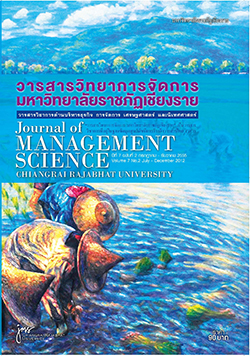Rainbow Oceans Strategy: Path Way to Business Sustainability
Main Article Content
Abstract
The purpose of the article was to present rainbow oceans strategy which was developed from relevant literature reviews and TQA criteria on organizational excellence as a path way toward business sustainability through modern entrepreneurs’ context in managing business amid environmental changes. Traditional entrepreneurs were lack of risk management, lack of innovation application and lack of understanding on rapid environmental changes. Hence, this rainbow oceans strategy was the path way to sustainability of business which comprised of 7 dimensions, i.e. (1) red ocean on competitive advantages, (2) blue ocean on innovation environment, (3) white ocean on good governance and social responsibility, (4) pink ocean on stabilizing stakeholder requirements, (5) yellow ocean on working process, information and performance measurements, (6) green ocean on learning and knowledge management and (7) orange ocean on enterprise risks management for modern entrepreneurs to drive their business toward sustainability.
Article Details
Views and opinions expressed in the journal do not necessarily reflect those of the editors.
References
ดนัย จันทร์เจ้าฉาย. (2553). กลยุทธ์น่านน้ำสีขาว. กรุงเทพมหานคร: ดีเอ็มจี บดินทร์ วิจารณ์. (2550). HR กับองค์กรที่เป็นเลิศตามแนวทางรางวัลคุณภาพแห่งชาติ (Thailand Quality Award: TQA) “วารสารการบริหารตน”, 28(4): 58-61. ประเสริฐ เพชรชื่นสกุล และคณะ. (2553). น่านน้ำแห่งความรัก. กรุงเทพมหานคร: เพียร์สันเอ็ดดูเคชัน อินโดไชน่า วิจารณ์ พานิช. (2550). การบริหารงานวิจัย : แนวคิดจากประสบการณ์. (พิมพ์ครั้งที่ 2) กรุงเทพมหานคร.ดวงกมล. สำนักงานรางวัลคุณภาพแห่งชาติ. (2555). เกณฑ์รางวัลคุณภาพแห่งชาติ ปี 2555-2556. กรุงเทพมหานคร: พงษ์วรินการพิมพ์ สำนักงานรางวัลคุณภาพแห่งชาติ. (2552). เรียนจากแชมป์เพื่อเป็นแชมป์. กรุงเทพมหานคร: พงษ์วรินการพิมพ์ สำนักงานรางวัลคุณภาพแห่งชาติ. (2549). Best Practices: TQA Winner 2006. กรุงเทพมหานคร: อินโนกราฟฟิกส์ สำนักงานรางวัลคุณภาพแห่งชาติ. (2548). Behind the Scenes” TQC Winner 2005. กรุงเทพมหานคร: พงษ์วรินการพิมพ์ สัณฐิตา กาญจนพันธ์. (2555). ชีวิตนาคร. [Online] Available: http://www.human.cmu. ac.th/Huge/huge104/data/104-19.pdf. ค้นเมื่อ 9 มิถุนายน 2555. อำนาจ วัดจินดา. (2550). การพัฒนาทรัพยากรมนุษย์. “วารสารดำรงราชานุภาพ”, 6(22): 17-23.
ภาษาอังกฤษ
Ashton, T.S. (1997). The Industrial Revolution (1760-1830). Oxford: Oxford University Press. Bessant, J., & Tidd, J. (2011). Innovation and Entrepreneurship, (2rd ed.). New Jersey: John Wiley and Sons. Boulnois, L., & Loveday, H. (2004). Silk road: Monks, Warriors & Merchants on the Silk Road, Hong Kong: Odyssey Publication. Boyett, J.H., & Boyelt, J.T. (2001). The guru guide to the knowledge economy: The best ideas for operating profitably in a hyper-competitive world. New York : John Wiley & Sons. Denning, P., & Dunham, R. (2010) The Innovator’s Way: Essential Practices for Successful Innovation, Boston: Toppen Best-set Premedia. Divine, R. A., & Others. (2010). American Past & Present, (7th Ed.). New York: Pearson Education. Fraser, J., & Simkins, B. J. (2010). Enterprise Risk Management. New Jersey: John Wiley and Sons. Hill, C.W. (2010). International Business: Competing in the Global Marketplace, (8th ed.) New York: McGraw-Hill. Kaplan, R. S., & Norton, D. P. (1996) The Balanced Scorecard: Translating strategy into action, Boston: Harvard Business School Press Kim, W.C., & Mauborgne, R. (2005). Blue Ocean Strategy: How to Create Uncontested Market Space and Make the Competition Irrelevant, Boston: Harvard Business School Publishing Corporation. Kim, W.C., & Mauborgne, R. (2012) Conversation with W. Chan Kim and Renee Mauborgne, INSEAD, Paris. [Online] Available: http://www.insead.edu/ alumni/newsletter/February2005/Interview.pdf. ค้นเมื่อ 13 พฤษภาคม 2555. Larcker, D.F. (2011). Organizational Strategy, Business Models, and Risk Management. Stanford Graduate School of Business. Corporate Governance Research Program, [Online] Available http://www.gsb.stanford.edu/cgrp ค้นเมื่อ 14 พฤษภาคม 2555. Malhotra, Y. (2005). Integrating knowledge management technologies in organizational business processes: getting real time enterprises to deliver real business performance, Journal of Knowledge Management, 9(1):7-28. Kuckertz, A., & Wagner, M. (2010). The influence of sustainability orientation on entrepreneurial intentions investigating the role of business experience, Journal of Business Venturing, 25 (2010) 524–539. Papazoglou, M. P., & Ribbers, P. M. (2006). e-Business: Organization and Technical Foundations. New Jersey: John Wiley and Sons. Peter, J.P., & Olson J.C. (2010). Consumer Behavior and Marketing Strategy, (9th ed.), New York: McGraw-Hill. Porter, M.E. (1980). Competitive Strategy: Techniques for Analyzing Industries and Competitions, New York: Free Press. Schendel, D., & Hofer, C. (1979). Strategic Management: A New View of Business Policy and Planning. Boston, Massachusetts: Little, Brown. Schumpter, J. (1994) A History of Economic Analysis. London: Routledge. Wang, C. L. (2008). Entrepreneurial orientation, learning orientation, and firm performance, Entrepreneurship Theory and Practice, 32(4): 635-656. Weerawardena, J. (2003). Exploring the role of market learning capability in competitive strategy, European Journal of Marketing, 37(3): 407-429. Green, K.M. , Covin, J. G., & Slevin, D. P. (2006). The relationship between strategic adaptability and entrepreneurial orientation: The role of structure-style fit. Frontiers of Entrepreneurship Research, 26(23): 1-14.

